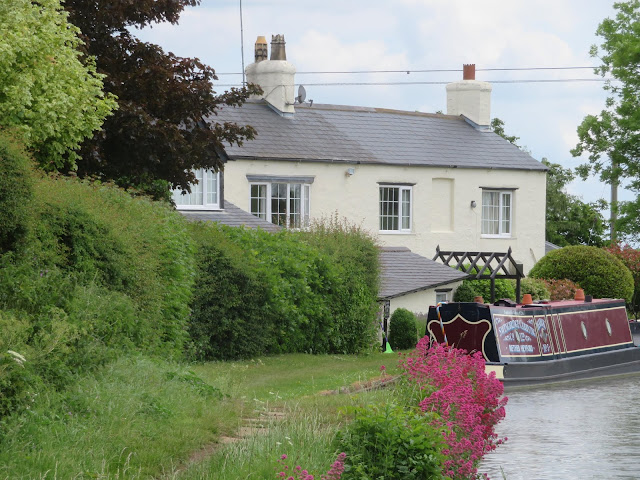Being a Sunday we had a lay in before walking into Nether Heyford for a paper and a look see.
 After completing that task I was gagging for a pint so we went for a walk into Bugbrooke. The lane from the canal had these poppies growing in the verges, with loads more still to open.
After completing that task I was gagging for a pint so we went for a walk into Bugbrooke. The lane from the canal had these poppies growing in the verges, with loads more still to open.
There is a one stop shop and a butchers and bakers and after picking up the goods we walked into the old part of the village. It has nice narrow streets with lovely warm iron stone buildings. To the south west of the village a couple of iron works were established in the 1850's and survived about fifty years.
I'm not sure why but there are several three story buildings in the village. Here, in dark brick is the date 1859
The church of St. Peter and St. Paul dates from the 13th century but was much altered in the 1800's
The village green in Nether Heywood was actually gracing for cattle until 1951.
Once we got back we had a cup of tea and then set off for our short trip. Just after Bridge 29 there is a narrows for an old swing bridge with stone crop growing from it with the old house and boat in the background.
At bridge 32 we were flagged down by a bloke from a boat wanting a lift down the cut to Bridge 35. There are loads of moored boats on this stretch so it would have been quicker walking, but we had a nice caht as we went along. We decided to moor up just before Bridge 35 and here we are. We stopped for lunch and then I decided to wash the port side and then polish it. It looks a lot better now.
 After completing that task I was gagging for a pint so we went for a walk into Bugbrooke. The lane from the canal had these poppies growing in the verges, with loads more still to open.
After completing that task I was gagging for a pint so we went for a walk into Bugbrooke. The lane from the canal had these poppies growing in the verges, with loads more still to open.
This house on the main street in Bugbrooke took my fancy. The date stone says RPB 1789. The stone is actually a marl that is a type of sandstone that is coloured by its iron content.
I was also taken by this terrace of buildings also on the main street. The stone colour is very warm, and photogenic.
As we walked back from the village down the tow path the high flags add a splash of colour, with 'Holderness' showing through the bridge hole.
We got a good TV picture and had a good tea and settled in for the evening.









No comments:
Post a Comment